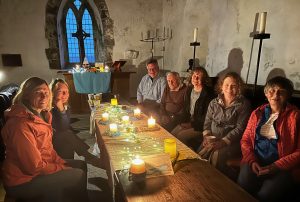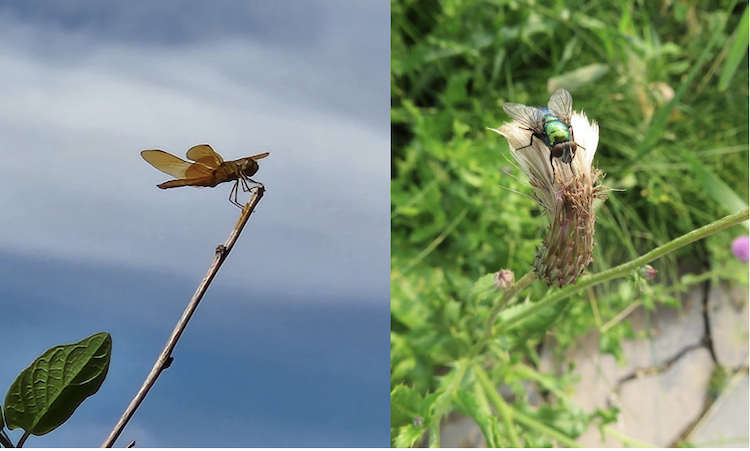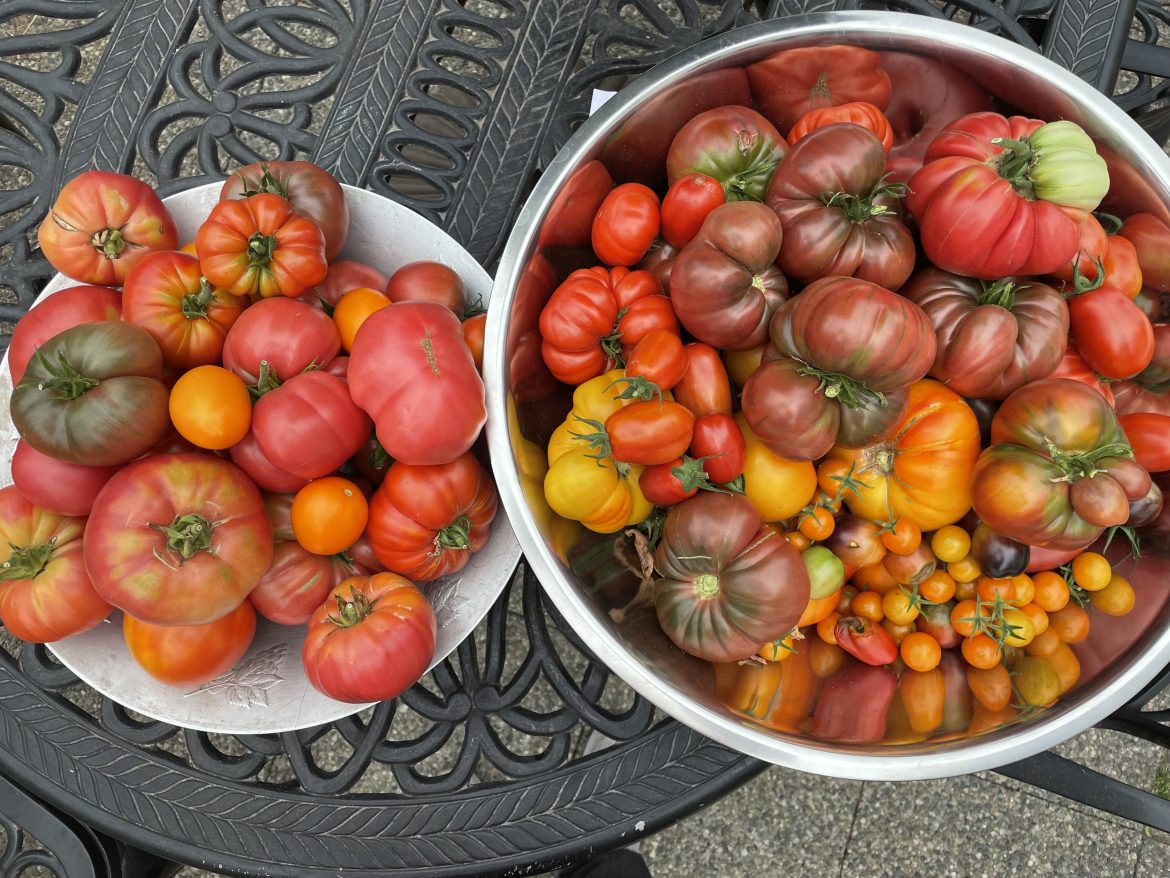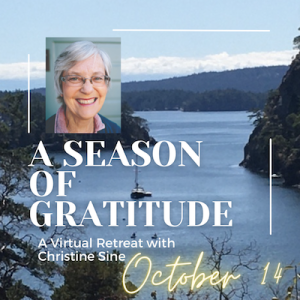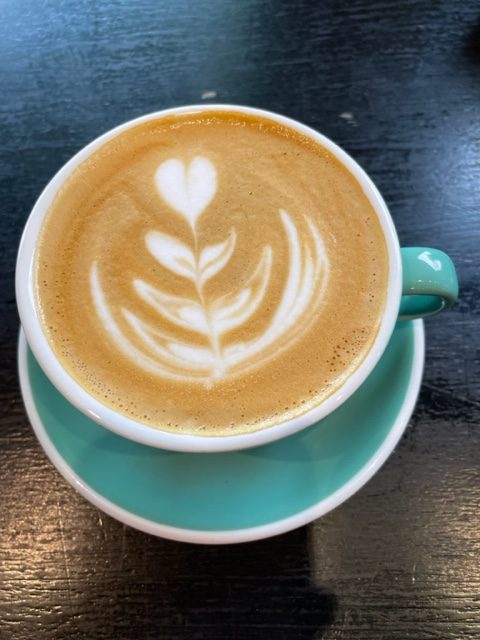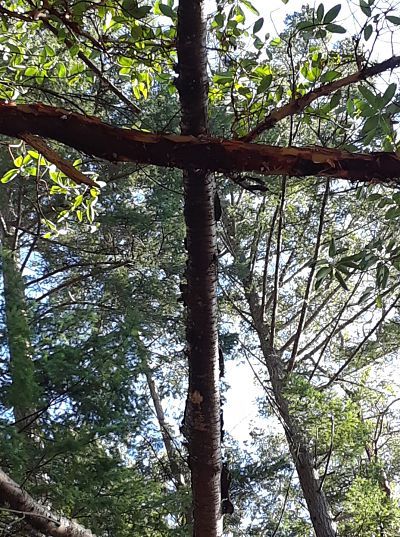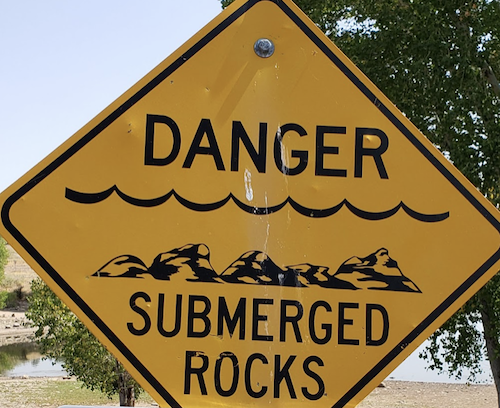I’m sitting in the lounge (living room) of some of my dearest friends, Martin and Sally Poole, in Brighton, England. We haven’t seen each other in real life since before Covid lockdown. They were supposed to visit and stay with us in Nashville in the summer of 2020. I was supposed to visit them last May but Covid and then my covid fears prevented those visits.
So it was such a gift to arrive at the vicarage yesterday and hug them in real time!!!
Martin and I met when we were on a panel on Curating Worship at the Greenbelt Festival in the early 2000’s. We both were involved in curating worship and had our friend Mark Pierson to thank for it! Martin was the Worship curator for the Greenbelt festival for several years and invited me to come create/curate a Sacred Space prayer room for the festival in 2013. I used to come regularly to the festival to fill up my cup and learn from the creatives in the UK who were doing outside the box church and worship. He and I led the opening worship for the first Wild Goose Festival in 2011. Martin is the Vicar at St. Luke’s Prestonville and the pastor of Beyond Church,
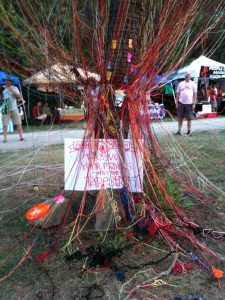
Burning Bush Yarn tree Wildgoose
Sally is a teacher and has an amazing gift of hospitality. We hit it off as soon as we met! In 2015 we came at Christmas and got to experience the Beach Hut Advent Calendar in REAL LIFE! For ten years, Martin, Sally and Beyond hosted the Beach Hut Advent Calendar on the sea front here. Each evening in December one of the beach huts would open it’s doors and inside would be a beautiful art display on the theme of the year. Sometimes schools would adopt a hut and sing carols and create the inside decor. Mulled wine and mince pies followed the opening of the Advent Hut door each evening regardless of the weather. It became a wonderful December tradition for the whole community.
Martin just launched a new book CHURCH BEYOND WALLS! and I am excited to have a real copy and cannot wait to read it! It’s the story of how creativity and getting out into the community can change the world. ” The goal and aim of this book is to help local churches everywhere recognize the opportunities for epiphanies, moments when the divine can break into human experience- wherever they are. It offers ideas and and shares resources, and builds confidence to enable them to create inspiring and stimulating encounters with the divine.” (from the book jacket). I am going to get Martin to write a freerangefriday on this to tell you more!
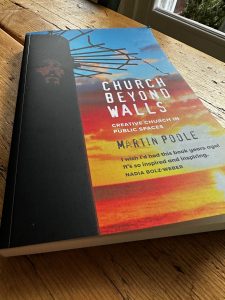
Martin’s NEW BOOK
As I type this, I am so aware of God’s gifts of abundant love! Friendship is a true gift! and Kindred Spirits are hard to find! Martin and Sally are both!
This past few days of leading/curating the Finding your Thinplace Pilgrimage Retreat have been filled with so much abundance, so many gifts!
Why is it that we so easily forget, and so often doubt the abundance of God? We forget the loaves and fish, the healings, the water into wine.
This past few days I’ve experienced so much ABUNDANCE ! I am so grateful for the pilgrims who traveled with me! So grateful that I listened to the Holy Spirit last year and finally did a dream that I’ve had for 20 years! And I am grateful for all the friends who prayed for us! I had friends praying for the details of travel and for the weather that can be quite wet in late August and early September. (And all of the UK had a very wet summer.) I even had my friend Lynne pray against the MIDGES! And we had the most spectacular weather! The pilgrims got to see Scotland in all her glory! We didn’t even need our rain gear! We got wet in Oban but dried out and had a beautiful abundant tea with scones and sandwiches and chocolate brownies that were too good to be true! More abundant love from Jesus! The ferries and the trains all ran on time! The taxis showed up too! And Jesus was in all the details in our worship times and our walk abouts, and time of exploration and contemplation!
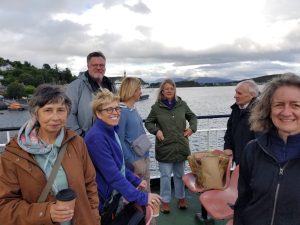
PILGRIMS ON THE WAY TO IONA
As my friend Kathy Escobar says! #beautyheals! And Scotland and Jesus healed us with beauty!
This weekend, I invite you to consider the ABUNDANCE of God. How have you experienced God’s gifts lately? Take a walk somewhere beautiful and ask Jesus to show you and remind you of his abundant love! Take some time and journal about how you have experienced the abundance of God in your life throughout the years. It’s always good to remember. Who are the friends you’ve encountered, the kindred spirits in your life who have been abundant gifts to you? Take time to thank Jesus for them and take a moment to connect with them by text, phone, a card.
TODAY Receive the wonderful ABUNDANCE of Jesus!
My response is to get down on my knees before the Father, this magnificent Father who parcels out all heaven and earth. I ask him to strengthen you by his Spirit—not a brute strength but a glorious inner strength—that Christ will live in you as you open the door and invite him in. And I ask him that with both feet planted firmly on love, you’ll be able to take in with all followers of Jesus the extravagant dimensions of Christ’s love. Reach out and experience the breadth! Test its length! Plumb the depths! Rise to the heights! Live full lives, full in the fullness of God. EPHESIANS 3: 14-19 THE MESSAGE
by June Friesen
What might it be like to live under God’s shield? In several places in the Scriptures it references how living close to God, following God, and obeying God all help us to know our lives will be protected. However, the challenge may be how or what that protection looks like. Does that mean I will have no big catastrophes in my life? Does that mean that I will not have temptations or problems on a daily basis? When I think of a shield I think of something that is strong and I usually think of it as being metal because I feel security behind metal more so than wood or other materials. One reference that is often used when talking about a shield is from Ephesians in reference to one’s faith. In the Philips translation Ephesians 6:16 reads: “…be sure you take faith as your shield, for it can quench every burning missile the enemy hurls at you.” Definitely when we are actively walking with God we will be more able to ward off wandering after the enemy’s false leading. If one reads the whole of Ephesians 6 we become aware of the fact that it says this is to be a daily habit.
I would like to share another scripture from the Psalms. Psalm 34 gives a more complete explanation in how one’s life can be actively alert to God’s ways and plan.
Psalm 34
I bless God every chance I get; my lungs expand with his praise.
2 I live and breathe God; if things aren’t going well, hear this and be happy:
3 Join me in spreading the news; together let’s get the word out.
4 God met me more than halfway, he freed me from my anxious fears.
5 Look at him; give him your warmest smile. Never hide your feelings from him.
6 When I was desperate, I called out, and God got me out of a tight spot.
7 God’s angel sets up a circle of protection around us while we pray.
8 Open your mouth and taste, open your eyes and see— how good God is.
Blessed are you who run to him.
9 Worship God if you want the best; worship opens doors to all his goodness…..
14 Turn your back on sin; do something good. Embrace peace—don’t let it get away!
15 God keeps an eye on his friends, his ears pick up every moan and groan.
16 God won’t put up with rebels; he’ll cull them from the pack.
17 Is anyone crying for help? God is listening, ready to rescue you.
18 If your heart is broken, you’ll find God right there;
if you’re kicked in the gut, he’ll help you catch your breath.
19 Disciples so often get into trouble; still, God is there every time.
20 He’s your bodyguard, shielding every bone; not even a finger gets broken.
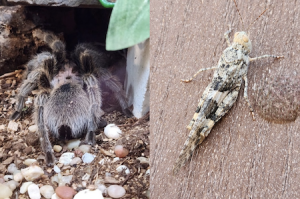
Recently I have been challenged in my own thoughts and life walk about how I can fully embrace life instead of struggle with the fear that wants to drag me down. While I am intrigued as well as fascinated by bugs I also have a healthy respect as well as fear of some of them. It is interesting how some of the smaller ones can be the most annoying and bothersome as well as more dangerous than the big ones. Above you will see a photo I took of a tarantula. We have them in Arizona as well as black widow spiders. Both have a venomous bite however the black widow bite is much more serious than the tarantula. A tarantula however is much larger and easier to see than a black widow. I remember one time opening one of my drawers with t-shirts in it to find a black widow hanging there on a web she had woven over the top of the shirts. I do not have any recollection what I did at that point but I do know we had to get it outside. Bees are another interesting insect that are very needed in our ecology of nature. Actually all insects serve a purpose in ecology, some maybe more needed than others. However bees can also pose a problem for humans, especially those who are allergic to them. Then of course there are ants and flies and so many more – again they all have some usefulness as well as can be annoying and bothersome. It is kind of that way with humanity as well. I have to kind of smile as I think that yes, each one of us is needed and necessary. Some may appear and seem more useful and pleasant than others yet God’s design is for all of us to get to know Him and develop a relationship with Him. One of the things that is necessary for you and I to be useful in God’s kingdom here on earth is for each one of us to live or ‘Be under God’s shield.’ And that my friends spells BUGS. Yes, today I want to leave a challenge for each one of us – to adopt a spiritual bug: BE UNDER GOD’S SHIELD. It is a challenge to live out our life by truly living under God’s direction, protection and power – all empowered by God’s love.
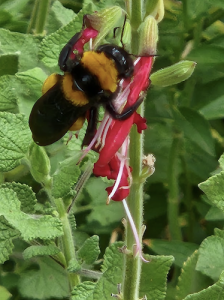 BUGS, BUGS, BUGS
BUGS, BUGS, BUGS
Have you ever wondered why God created bugs?
Especially those bugs that bite and buzz around your head?
And then there are those who try to share your dinner with you –
And others who just look creepy and crawl everywhere.
And then there are those bugs that build their homes in the worst places –
They have no care that it is where you want to look out the window
Or if it is where you want to sit or walk –
Or that it is a cupboard where you store those seldom used things.
Bugs, bugs, bugs –
God how in the world do you expect me to cope
With these little annoying creatures –
Oh but wait a minute, there are those that are rather big as well – UGH!
Then there are those people who bug me –
Some days and times their bugging is rather welcome,
As I may be feeling down or alone or rather bored;
But then there are others and other days when that is definitely not the case.
Bug, bug, bug – what is it that you want from me?
Why is it you are annoying me to the point of anger?
Don’t make me tell you off.
Don’t make me do something you or I will regret.
God, what is it you want me to do with this person who is bugging me?
Should I ignore them, or hit them, or hurt them physically or with words?
What? You want me to love them. You want me to control my anger.
Come on God how in the world can I do that?
My child, take some time alone to pray,
First tell me all it is that bothers you about this person and your problem;
Then take some time to sit quietly with me and ponder that I love the both of you,
And then please open your spirit and I will fill it with love for them like you never could have imagined.
BUGS = Be Under God’s Shield
J. Friesen 2016
The writing at the end I wrote in 2016. All photos are by June Friesen. Scripture is from the J.B. Phillips translation.
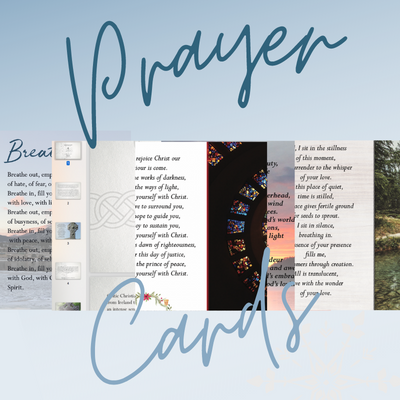 Prayer cards are available in the shop for many occasions and seasons–from everyday pauses and Lenten ruminations to breath meditations and Advent reflections, enjoy guided prayers and beautiful illustrations designed to delight and draw close. Many are available in single sets, sets of three, and to download–even bundled with other resources!
Prayer cards are available in the shop for many occasions and seasons–from everyday pauses and Lenten ruminations to breath meditations and Advent reflections, enjoy guided prayers and beautiful illustrations designed to delight and draw close. Many are available in single sets, sets of three, and to download–even bundled with other resources!
by David Pott
As a result of Richard Rohr’s teaching I suspect that many people around the
world are now using Yahweh as a breath prayer, breathing in on Yah and out
on weh. However I have found it helpful as I come into God’s presence to add
two more Hebrew words as breath prayers. They are the Hebrew name for
Jesus, Yeshua and the Hebrew word Ruach which is translated in the Bible as
wind and spirit and, appropriately in this context, also as breath. The
references to spirit apply to the human spirit but also to the Spirit of God.
So then we have these three Hebrew names for God – Yahweh (יהוה),
Yeshua (ַשועֵי) and Ruacḥ (רוח) that can all be used as breath prayers in this
way: Yah-weh, Ye-shua, Ru-ach. It is interesting that all three names have no
hard consonants and they are not very different from the sounds of breathing.
Sometimes I breathe each name three times and at other times I say the three
consecutively, again quite often three times. At other times I might focus for a
while on just one of the three. I use the names as breath prayers when I am
walking and they can go well with various exercises that assume a worshipful
posture, such as this one:
Kneel in front of a chair and place your hands on top of the front of the seat,
keeping your arms straight. Breathe in as you begin in an upright position,
then on the out breath, slide your arms forward to the back of the seat and
bend your knees to crouch so your head will be down near the front of the
seat.
I find that I sometimes use these breath prayers where previously I may have
said “In the name of the Father, and of the Son and of the Holy Spirit.” I find
using the Hebrew names feels like a closer connection to the roots of our faith
and especially when I think Jesus would understand all these words. In
referring to Father God, Jesus used both Abba and Yahweh and he would be
familiar with Isaiah 64:8, “O Lord (Yahweh), you are our Father.” With regard
to his own name, he would not have turned round if someone had called out
“Jesus” to him as he walked through Jerusalem or Galilee, but Yeshua he
certainly knew!
One of my favourite scriptures is John 14:23, “If anyone loves Me, he will keep
My word; and My Father will love him, and We will come to him and make Our
home with him.” I find that utterly astonishing, and for me using these breath
prayers of their names is an act of welcome and intimacy helping to increase
the wonder of this indwelling.
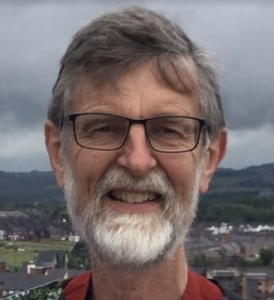 David Pott worked for ten years in drug rehabilitation centres and
David Pott worked for ten years in drug rehabilitation centres and
detached youth work and then moved into teaching for 19 years. He was
head teacher of two independent schools. David is a keen naturalist and a
long distance walker. In 1997, he completed a 680 mile solo pilgrimage
from Iona to Canterbury called Peregrinatio 97 commemorating the
1400th anniversary of St Columba and St Augustine. He has led several
pilgrimages and walks with a reconciliation theme, such as the Offa’s Dyke
Torch March along the ancient boundary between England and Wales.
Between 2000 and 2007 David led the Lifeline Expedition and the March of
the Abolitionists – a series of reconciliation journeys in connection with the
legacy of the Trans-Atlantic slave trade which has received widespread
media attention. See www.lifelineexpedition.co.uk/mota and
David was involved in setting up the Two Saints Way, a pilgrimage route
between the cathedral cities of Chester and Lichfield which opened in
2012. See www.twosaintsway.co.uk He published the full colour guide
book in November 2015. David is also the founder of Flag Up Scotland
Jamaica – see www.flagupscotjam.uk
Since moving to Bishop Auckland in January 2016, David has been
involved in assisting with initiatives in connection with the regeneration of
the area and he has also been developing pilgrimage routes to the shrine
of St Cuthbert at Durham Cathedral. See www.northernsaints.com
David has been married to Pam since 1970 and their three children are all
married and they rejoice in nine grandchildren. Their son Joel was the lead
singer of the indie band Athlete and his song “Wires” won the Ivor Novello
award for the best contemporary song of 2006.
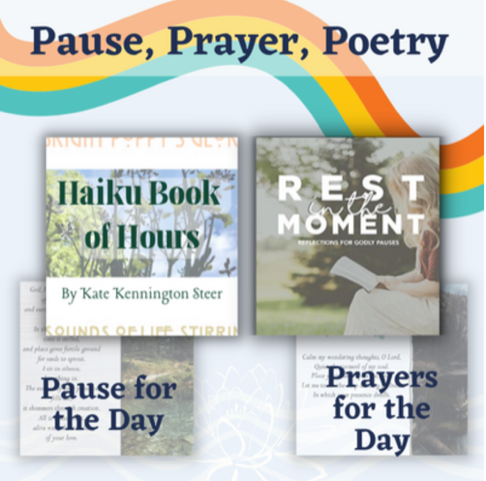 Whether you are praying the stations of the day, in need of resources for rest, hoping to spark joy and find wonder, or simply want to enjoy beautiful prayers, poetry, and art – our digital downloads section has many options! Christine Sine’s book Rest in the Moment is designed to help you find those pauses throughout the day. Praying through the hours or watches, you may find inspiration in our prayer cards set Prayers for the Day or Pause for the Day. You may find your curiosity piqued in the free poetry and art download Haiku Book of Hours. All this and more can be found in our shop!
Whether you are praying the stations of the day, in need of resources for rest, hoping to spark joy and find wonder, or simply want to enjoy beautiful prayers, poetry, and art – our digital downloads section has many options! Christine Sine’s book Rest in the Moment is designed to help you find those pauses throughout the day. Praying through the hours or watches, you may find inspiration in our prayer cards set Prayers for the Day or Pause for the Day. You may find your curiosity piqued in the free poetry and art download Haiku Book of Hours. All this and more can be found in our shop!
Welcome to September and to autumn in the northern hemisphere and spring in the southern. It’s a grey day in Seattle with some much needed rain. It is not just the weather that makes me aware of the changing seasons however. The huge maple tree outside my office window, what I call my sentinel tree, now has its red streak right down the centre. It is my red flame that heralds the arrival of a new season. I love it, even though I hate to say goodbye to summer and the wonderful parade of flowers that have blessed my life over the last few months.
Today, following my retreat on Seasons and Rhythms, I am more aware than ever of the changing seasons around us the many facets of our lives that dictate our rhythms and seasons. It was also a good reminder of our need to breathe deeply throughout the day something that surprisingly does not come naturally to us. In yesterday’s Meditation Monday: Rituals that Give Us Rhythm, I spelled out the two types of rituals or practices that are vital for a balanced life – rituals of restoration and of transformation. Practices like retreats provide important transformative anchors that help us adjust to the changes we anticipate, even to those that take us by surprise. Interestingly one of the aspects of the retreat that participants enjoyed most was the feeling of community we experienced as we talked together across the distances of thousands of miles. That sense of togetherness is, in itself, a restorative practice and space that we all desperately need.
On Saturday, following the retreat I engaged in one of my restorative practices during this season – harvesting and preserving the garden produce. First I picked tomatoes with community member Andrew, admiring the incredible variety of size, shape and colour of the fruit. Then I dried apples and tomato skins (wonderful for salad dressing and for winter soups) and today I am getting ready to make chocolate, pear bread, my new seasonal favourite which I will store in the freezer. So good to have supplies like this when unexpected guests drop in.
This week we have had some outstanding posts on Godspacelight. Kellie Brown inspired us with part 2 of her series What is Theopoetics, Elaine Breckenridge awed us with her fascinating look at the art of Susan Cohen Thompson, I love her compelling question “What might happen if more of us had our own awakening and began to view life with the eyes of nature? “ She also wrote a second post of a poem she wrote Madrone Chapel – not about a building but a tree that is her “threshold into transfiguration”. On Friday we were enriched by two posts – an update from Lilly Lewin who is currently leading a pilgrimage on Iona, and a beautiful reflection and poem by June Friesen The Risks of Living In This World. I love her poem, part of which I want to end with this week as it is a wonderful reminder that all of us need to let go as the seasons change and we prepare for a new season ahead.
Open your hands and let go –
Open your hands and spread your fingers –
Open your hands and shake them a bit –
Open your hands and blow over with your breath.
Let go of the struggles you are fighting –
Let go of the bondage that attempts to bind you –
Let go of the nagging thoughts that want to hold your mind captive –
Let go – release – and breathe – and think.
Let go of the could of, should of and would have….
Let go of the feelings of regret, sadness and anger…..
Let go of the negative feelings and attitude…..
Let go – – – – release – – – – breathe.
Release your being from the screaming of the world –
Release your mind from the control of the world –
Release your body members from the bondage of the enemy –
Release yourself to God’s Spirit – breathe deeply of Him and begin to live.
Breathe deeply of the Spirit’s Presence –
Allow Him to inhabit the depths of your soul –
Begin to embrace His life-giving Presence –
Now is when God-given life can really begin.
May you receive the wisdom and the guidance of God’s spirit in all you do this week
Join Christine Sine on October 14 or watch the recording later. October and November, the season between Canadian Thanksgiving and American Thanksgiving, is gratitude season on Godspacelight. Christine Sine will encourage you to enter into the practice of gratitude in this interactive retreat that will help us enter this season of gratitude with joy and delight in our hearts.
by Christine Sine
On Saturday I held my Rhythms and Seasons webinar, a fun time of creativity, reflection and discussion which I will share more about at a later date. In preparation for this time I reread my book Godspace: Time For Peace in the Rhythms of Life. In fact my original intention was to work straight from this book at the retreat. However God had other more exciting plans that stretched both me and the participants to consider Rhythms and Seasons in other ways. However, one place that I relied heavily on Godspace: Time for Peace in the Rhythms of Life, was in talking about rituals and celebrations. All seasons need rituals and celebrations to mark and anchor them. and I still find this understanding helpful.
According to Christian anthropologist Paul Hiebert there are two types of rituals, habits or practices we need in our lives, what he calls rituals of restoration and rituals of transformation.
Rituals of restoration are the most common. These are the practices that restore our faith in the beliefs that order our lives. They also connect us to and anchor us in the religious communities in which these beliefs are expressed. Restorative practices are highly structured & do not change from day to day though they may be adapted to the seasons either of earth or of church as these change. They reaffirm our sense of order & meaning in the universe, our community & our own lives. Most importantly, they intentionally connect our daily activities to the life, death & resurrection of Christ and also to the world in which we live.
Possibilities include a rhythm of prayer that reaffirms what we believe, sabbath practices, weekly church gathering, taking communion, following the liturgical calendar and the use of liturgical symbols like the sign of the cross, candles, and incense. I even find that writing prayers for Facebook each morning and preparing my blog posts is a stabilizing and restorative ritual.
For me it has been the establishment of rhythms rather than the actual practices that are important. The practices may change but I love to have a regular rhythm to the day, week and year. In fact the breaking of this rhythm is one thing I find destabilizing. Praying each day is an essential part of my faith practice but what those prayers look like changes from day to day, from week to week and from season to season. In the past I have enjoyed The New Zealand Prayer Book and David Adam’s The Rhythm of Life, but recently acquired a copy of Women’s Uncommon Prayers: Our Lives Revealed, Nurtured, Celebrated which I plan to start using as well as Margaret Silf’s Sacred SpacesL Stations on a Celtic Way. reading prayers and reflections each morning is one of the important anchors of my life.
Rituals of transformation are characterized by a high degree of creativity & have little repetitive structure. Their goal is to cut through the established way of doing things and restore a measure of flexibility and personal intimacy. In other words they stop our restorative practices becoming boring and stagnant. They enable our faith to grow and change, enabling us to adapt to the passages of life and changes in our culture. In the liturgical calendar, Advent & Lent were specifically designed with this intention. Prayer retreats, conferences and workshops can also accomplish this though these days it seems that such events are more geared towards reinforcing the status quo than changing it. Pilgrimage, Biblically based celebrations like Stations of the Cross can also accomplish this. Prayer walks, mission trips, even walking the labyrinth are all practices that maintain this type of flexibility.
When I was on the Mercy Ship Anastasis, when the ship was ready to sail to a new port, we held what was called a Moving of the Ark ceremony, harkening back to the fact that the Israelites would only break camp and move when the cloud over the ark of the covenant moved. We celebrated with a special worship service, sharing the good things that had happened in the port we were leaving, sharing communion and then learning a little about the new port we were heading towards as a time of preparation. I don’t live on a ship that moves every few weeks any more but I have learned the importance of marking milestones in my life journey in similar ways.
Celebrating the seasons in our world and in our life is a wonderful way to mark time and recognize the transitions that prepare us for change. I find an increasing number of people are looking for celebrations like Chalking the Door and the Celtic festivals of Imbolc to help them mark the seasons and the rhythm of their lives. Acknowledging transitions, looking back with gratitude and forward with anticipation is a wonderful, faith building exercise that all of us should practice on a regular basis.
What are the practices that provide both stability and flexibility in your spiritual life? What are your restorative and transformative habits that shape your faith?
I pause within this sacred grove
guarded and buttressed by Madrone.
A tree of knowledge, it finds the sun
twisting, turning, dropping a branch
letting light in and balancing darkness
forming a cross to hold the others.
It is my chapel
a threshold into transfiguration
who beckons me to bend
and balance light and dark within
so that I too become a sacred grove
and like Madrone hold the Cross as an icon
into the beauty and mystery of this world.
 Christine Sine is offering three seasonal, virtual retreats to explore living in balance and in line with the natural and liturgical rhythms of the year. Join her for one or all of them September 2, October 14 and December 9. These retreats will encourage us to center ourselves and our lives as we move through the seasons beginning in Fall and moving through Advent. They will be times of reflection, creativity and fun.
Christine Sine is offering three seasonal, virtual retreats to explore living in balance and in line with the natural and liturgical rhythms of the year. Join her for one or all of them September 2, October 14 and December 9. These retreats will encourage us to center ourselves and our lives as we move through the seasons beginning in Fall and moving through Advent. They will be times of reflection, creativity and fun.
by June Friesen
Recently when we were on one of our hiking adventures this sign caught my eye. While this sign was for those who would be kayaking and boating, I was immediately drawn to the words. Why? I thought of how it is in our lives at times – we are moving along quite easily and maybe even quickly and ‘boom’ there seems to be a collision of sorts. As I have pondered this sign, and this thought, I began to realize that this is something one can relate to in life. While it may not necessarily be a rock in our path, we still find a difficulty or problem that we have to face and navigate.
It was interesting as I thought about different people in the Scriptures and especially those who we often refer to as godly people or people who followed God. There is Noah who chose to build a boat at God’s command when the people up to that time had never even seen rain or at least not a rain that caused flooding. There was Abraham who followed God for miles and miles and even backtracked at times until God finally told him he could stop and settle. There was Ruth, David, Samuel, and many others in the Old Testament and it continues on in the New Testament especially with Jesus and on into the times after His Ascension with Peter, Paul, Stephen and others. So when it comes to you and I, I would say that this sign is also one that can give us some thoughts to ponder as well. For Scripture today I am going to refer to a passage where Jesus is quoted as He prayed in the Garden of Gethsemane.
Matthew 26: 36-46
Jesus went with them to a garden called Gethsemane and told his disciples, “Stay here while I go over there and pray.” Taking along Peter and the two sons of Zebedee, he plunged into an agonizing sorrow. Then he said, “This sorrow is crushing my life out. Stay here and keep vigil with me.”
39 Going a little ahead, he fell on his face, praying, “My Father, if there is any way, get me out of this. But please, not what I want. You, what do you want?”
40-41 When he came back to his disciples, he found them sound asleep. He said to Peter, “Can’t you stick it out with me a single hour? Stay alert; be in prayer so you don’t wander into temptation without even knowing you’re in danger. There is a part of you that is eager, ready for anything in God. But there’s another part that’s as lazy as an old dog sleeping by the fire.”
42 He then left them a second time. Again he prayed, “My Father, if there is no other way than this, drinking this cup to the dregs, I’m ready. Do it your way.”
43-44 When he came back, he again found them sound asleep. They simply couldn’t keep their eyes open. This time he let them sleep on, and went back a third time to pray, going over the same ground one last time.
45-46 When he came back the next time, he said, “Are you going to sleep on and make a night of it? My time is up, the Son of Man is about to be handed over to the hands of sinners. Get up! Let’s get going! My betrayer is here.”
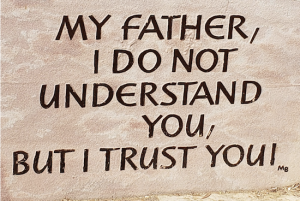 ‘My Father, I do not understand you, But I trust You.’ Have you ever found yourself at the point of using this in your prayer/prayers as you are seeking God for an answer? I have been at this point in my prayers in my own life as well as sometimes when I am praying for others.
‘My Father, I do not understand you, But I trust You.’ Have you ever found yourself at the point of using this in your prayer/prayers as you are seeking God for an answer? I have been at this point in my prayers in my own life as well as sometimes when I am praying for others.
I remember one time vividly in my life when I was in deep distress over a situation in my life over which I had absolutely no control. My heart was broken and I could only wonder ‘why me God?’ I had tried to do everything right. I had tried to help this person in so many ways. And I just could not understand why I was now in this present circumstance. In my desperation that day I went to our church sanctuary. There was a big wooden cross hanging at the front. I threw myself on the floor at the foot of that cross, sobbing my heart out, pounding my fists on the floor and cried out to God…..”WHY? WHY? I TRIED TO DO THINGS RIGHT. I DID MY BEST TO FOLLOW YOU. NOW THIS…..GOD, HOW COULD YOU LET THIS HAPPEN…..I JUST DO NOT UNDERSTAND.” I have no recollection of how long I stayed there, how long and hard I cried…..however this one thing I am sure of and that was God’s response to me. To me it seemed audible – whether it was or not I have no idea as I was there alone with God. God said, “June, I can do it ‘your way’ or I can do it ‘my way’. What is your choice?” Talk about being caught off guard – well I sure was. It was then I realized that God was at work in this whole situation and it then became my choice ‘to let go and let God,’ or to ‘demand God do what I wanted.’ (By the way I did let go, I did let God. It took a few more years but I have learned God had a plan quite different than mine. And it is an ‘okay plan).
A Gethsemane moment in my life. Letting go and letting God…..I work with so many people and this is one of the greatest struggles many people have and might I say it is a struggle in the lives of many Christians as well. The struggle is real, and Jesus told His followers that it would not be easy. We see evidence of this in Peter even with Jesus and then in the New Testament after Jesus’ ascension we see the struggles of the followers of Jesus.
LET GO…….LET GOD
Open your hands and let go –
Open your hands and spread your fingers –
Open your hands and shake them a bit –
Open your hands and blow over with your breath.
Let go of the struggles you are fighting –
Let go of the bondage that attempts to bind you –
Let go of the nagging thoughts that want to hold your mind captive –
Let go – release – and breathe – and think.
Let go of the could of, should of and would have….
Let go of the feelings of regret, sadness and anger…..
Let go of the negative feelings and attitude…..
Let go – – – – release – – – – breathe.
Release your being from the screaming of the world –
Release your mind from the control of the world –
Release your body members from the bondage of the enemy –
Release yourself to God’s Spirit – breathe deeply of Him and begin to live.
Breathe deeply of the Spirit’s Presence –
Allow Him to inhabit the depths of your soul –
Begin to embrace His life-giving Presence –
Now is when God-given life can really begin.
Embrace the new gifts you are being given –
Love, joy, peace, gentleness, kindness, patience –
Begin to live out the presence of these wonderful gifts
And give unto others of them as you have been given.
The world around you will begin to change for the good –
Love will be shared among many around you and it will grow –
Peace will begin to be acknowledged and embraced and overflow –
Joy will become a bubbling overflow from your presence to the world –
Gentleness shown will calm those around you –
Kindness will be doubled as those receiving will begin to share as well –
Patience will begin to arise slowly and its blessings will begin to multiply.
And so it is my friend that you and I can begin to impact the world with God’s energy –
They may not recognize it as God at first
But when they begin to see the trickling, spreading and growing effects
They will not be able to help themselves from exclaiming –
“Indeed life is all about a God-infused life – and living a God-infused life. No one and not even me may understand it – but oh how we will begin to embrace and live it. And in all that we do and say my it truly be that God’s name will be forever honored and glorified in and through us. In Jesus’ Name, Amen.
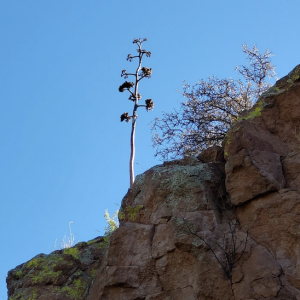 Photos by June Friesen. Scripture is from the Message Translation.
Photos by June Friesen. Scripture is from the Message Translation.
 Christine Sine is offering three seasonal, virtual retreats to explore living in balance and in line with the natural and liturgical rhythms of the year. Join her for one or all of them September 2, October 14 and December 9. These retreats will encourage us to center ourselves and our lives as we move through the seasons beginning in Fall and moving through Advent. They will be times of reflection, creativity and fun.
Christine Sine is offering three seasonal, virtual retreats to explore living in balance and in line with the natural and liturgical rhythms of the year. Join her for one or all of them September 2, October 14 and December 9. These retreats will encourage us to center ourselves and our lives as we move through the seasons beginning in Fall and moving through Advent. They will be times of reflection, creativity and fun.
As an Amazon Associate, I receive a small amount for purchases made through appropriate links.
Thank you for supporting Godspace in this way.
When referencing or quoting Godspace Light, please be sure to include the Author (Christine Sine unless otherwise noted), the Title of the article or resource, the Source link where appropriate, and ©Godspacelight.com. Thank you!


